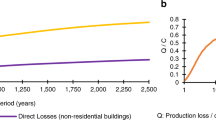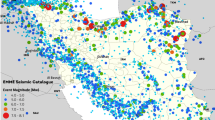Abstract
Most earthquake loss studies use a probabilistic approach in which predicted damages in various categories of structure and facilities in the region in concern are estimated and added together to obtain a total loss for particular intensity ranges. Such an approach requires a detailed inventory database of the structures and facilities in the region, which is not always readily available in many regions of the world. We have used an alternative means of estimating earthquake losses based on several macroeconomic indices such as the gross domestic product and population. Using published earthquake loss data for 1980–1995, the relations between GDP and earthquake loss have been formulated empirically for several intensity ranges. The world's land surface was divided into unit cells 0.5° lat. × 0.5° long. in size. The GDP of each cell was apportioned based on its population and GDP, and the population of the region to which it belongs. The predicted seismic loss of the cell was then estimated from the seismic hazard probability function, its GDP, and the empirical relation between GDP and seismic loss. A global seismic loss map is then compiled both for the intensity at 10% probability of exceedance and the probable maximum intensity. Employing readily available socioeconomic data as the basis for the vulnerability analysis, the method enables us to obtain seismic loss estimates for regions without the need for a detailed inventory of exposed structures or collateral geological information. Since such statistics are frequently compiled by the world's leading political and financial institutions, the seismic loss estimates can also be upgraded easily for the fast developing areas of the world.
Similar content being viewed by others
References
Algermissen, S. T.: 1989, Techniques and parameters for earthquake risk assessment, Bull. New Zealand Nat. Soc. Earthquake Eng. 22, 202.
Applied Technology Council: 1985, Earthquake damage evaluation data for California (ATC-13), Redwood City, California, Applied Technology Commission.
California Department of Finance: 1995, California Statistical Abstract: 1995, Sacramento, California, Issued November, 1995.
Chen, Y., Chen, X., and Fu, Z.: 1992, Estimating Losses from Earthquakes in China in the Forthcoming 50 Years, Seismological Press, Beijing.
Dunbar, P. K., Lockridge, P. A., and Whiteside, L. A.: 1992, Catalog of significant earthquakes (2150 B. C.-1991 A. D.), Report SE-49, World Data Center A for Solid Earth Geophysics, September 1992.
Panel on Earthquake Loss Estimation Methodology: 1989, Estimating Losses from Future Earthquakes, Panel Report, National Academy Press, Washington DC, 57 pp.
Research Group of Chinese Earthquake Risk Prediction in Ten Years: 1995, Atlas of Earthquake Risk Prediction in China, Science Press, Beijing, 46 pp.
Rogers, A. M., Algermissen, T., Hays, W. W., and 6 others: 1976, A study of earthquake losses in the Salt Lake City, Utah Area, Open-file Rep. 76-89, US Geol. Sur., Washington DC.
State Statistical Bureau of China: 1996, Statistical Yearbook of China 1996, China Statistical Publishing House, Beijing, China.
Steinbrugge, K. V., Algermissen, S. T., Lagorio, H. J., Cluff, L. S., and Degenkolb, H. J.: 1981, Metropolitan San Francisco and Los Angeles earthquake loss studies; 1980 assessment, Open-File Rep. 81-113, U. S. Geol. Sur., U. S. A., 46 pp.
Steinbrugge, K. V., Bennett, J. H., Lagorio, H. J., and 3 others: 1987, Earthquake planning scenario for a magnitude 7.5 earthquake on the Hayward fault in the San Francisco Bay Area, Calif. Dept. Conservation, Sacramento, 243 pp.
Tobler, W., Deichmann, U., Gottsegen, J., and Maloy, K.: 1995, The Global Demography Project, Technical Report TR-95-6 National Center for Geographic Information and Analysis, Department of Geography, University of California, Santa Barbara.
United Nations: 1994, Statistical Yearbook (Thirty-eighth issue, CD-ROM), United Nations Publications.
Wang, L. R. L., Wang, J. C. C., and Ishibashi, I.: 1991, GIS applications in seismic loss estimation model for Portland, Oregon water and sewer systems, U. S. Geol. Sur., U. S. A., 71 pp.
World Bank: 1995, World Development Report 1994: Infrastructure for Development, Oxford University Press.
Yeats, R. S., Sieh, K., and Allen, C. R.: 1997, Geology of Earthquakes, Oxford, New York, 568 pp.
Zhao, R. and Chen, Y.: 1993, The global seismicity and earthquake disasters in 1992, Recent Developments in World Seismicity 4, 1-6, 1993.
Zhao, R. and Chen, Y.: 1994, Outline of worldwide earthquakes disasters in 1993, Recent Developments in World Seismicity 8, 12-15, 1994.
Zhao, R.: 1995a, Overview of worldwide damaging earthquakes in 1994, Recent Developments in World Seismicity 8, 10-14, 1995.
Zhao, R.: 1995b, Overview of worldwide damaging earthquakes occurring in the half of 1995, Recent Developments in World Seismicity 11, 14-19, 1995.
Rights and permissions
About this article
Cite this article
Cha, L.S. Assessment of Global Seismic Loss Based on Macroeconomic Indicators. Natural Hazards 17, 269–283 (1998). https://doi.org/10.1023/A:1008060510137
Published:
Issue Date:
DOI: https://doi.org/10.1023/A:1008060510137




